Vendor onboarding can be tedious and time-consuming, but it’s an essential component of your supply chain strategy. Following best practices and a strategic workflow can streamline the vendor onboarding process and ensure success.
In this comprehensive guide, we’ll look at key factors to consider during the vendor onboarding process and how SupplierGateway can help simplify the process and save your organization time and money.
Preparing for the Vendor Onboarding Process
Onboarding is the process of collecting and sharing information to build a relationship with a new vendor — and it’s a critical aspect of your company’s supply chain.
Fortunately, setting up and managing vendor onboarding can be easy with the right approach. When done correctly, onboarding can be integral to your company’s success. Not having a vendor onboarding program can cost your business money and expose your business to undue risks.
To start on the right foot, you should begin by understanding the basics of vendor onboarding. This involves developing a systematic process for evaluating an incoming supplier to make sure their quality and performance standards meet your expectations. As part of this evaluation process, it is important to create a comprehensive checklist that covers:
- Due diligence processes
- Risk assessments
- Supplier contracts
- Quality assurance measures
- Operational procedures
A standard, easy-to-follow onboarding checklist guarantees that you can correctly track each supplier’s onboarding process and that all suppliers meet your company’s criteria quickly and efficiently.
Assessing Your Vendor Risk
Now that you’ve identified and selected the right vendors, it’s time to assess the associated risk. Vendor risk assessment is a process that looks at each vendor’s qualifications, capabilities, and the impact of the risks posed to your organization should anything go wrong in your relationship. It is critical when implementing vendor onboarding best practices.
While assessing vendor risk is critical, it can take a vast amount of time and slow down your business. Lengthy supplier intake questionnaires take forever to complete for suppliers. Reviewers often miss important information buried among unnecessary information.
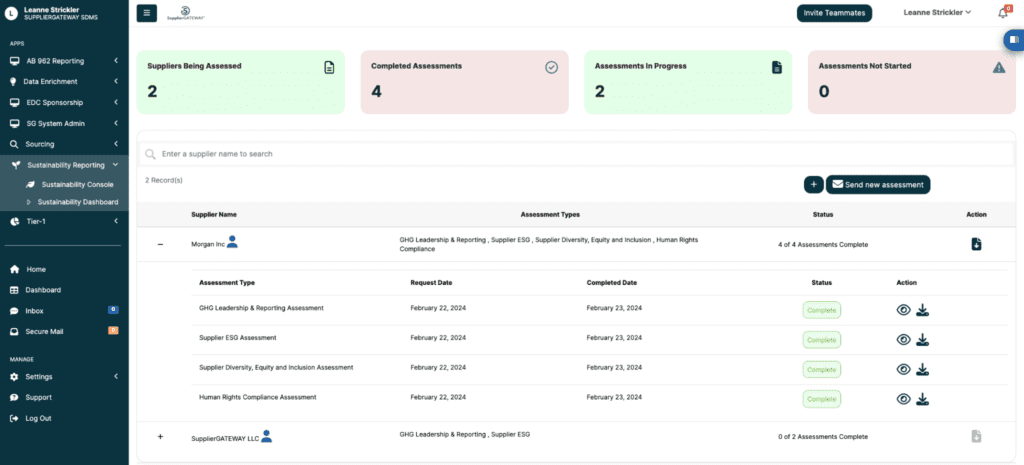
Reduce vendor risk with SupplierGateway’s risk assessments.
According to Gartner, you should streamline your supplier intake questionnaires by considering what constitutes high risk to your organization and focus your vendor risk assessments in those areas.
Common risk categories include but are not limited to:
- Qualifications: Is the supplier qualified to meet your organization’s standards?
- Capabilities: Does the supplier have the physical and digital infrastructure necessary to deliver their services?
- Financial Risk: What would the financial impact be if your relationship with this vendor breaks down or ends?
- Reputational Risk: How might a relationship with this vendor affect your organization’s brand image?
- Regulatory Risk: Are there any potential risks associated with government regulations and compliance laws if you work with this supplier?
By assessing risk components that most impact your business, you can ensure that new vendors or suppliers are an asset rather than a liability for your business.
Establishing Vendor Management Policies and Procedures
If you’re looking for an easy-to-understand vendor onboarding checklist that includes best practices, establishing vendor management policies and procedures should always be top of mind. In many cases, these policies determine the entire direction of your procurement process—from supplier selection and onboarding to vendor compliance workflows and ongoing performance reviews.
So what deliverables should you include in your vendor management policy? Here are some processes to focus on when creating vendor management policies.
Vendor Selection
An effective vendor onboarding process should include criteria for choosing suppliers, assessing and evaluating suppliers, and assessing supplier risk. All of this must align with your stated objectives and corporate sourcing strategy.
Data Collection
Your vendor onboarding process should also include a strategy for vendor master data collection. Gather critical vendor data like contact information, supplier capabilities, payment terms, and contract sign-offs. Getting the data from the supplier instead of piecing together data from spreadsheets and emails helps ensure data accuracy and completeness.
Communication
The success of any partnership depends on communication. Establishing clear communication channels with regular check-ins can help avoid problems from occurring down the road. Your policy should also lay out protocols for addressing issues or resolving disputes if they arise.
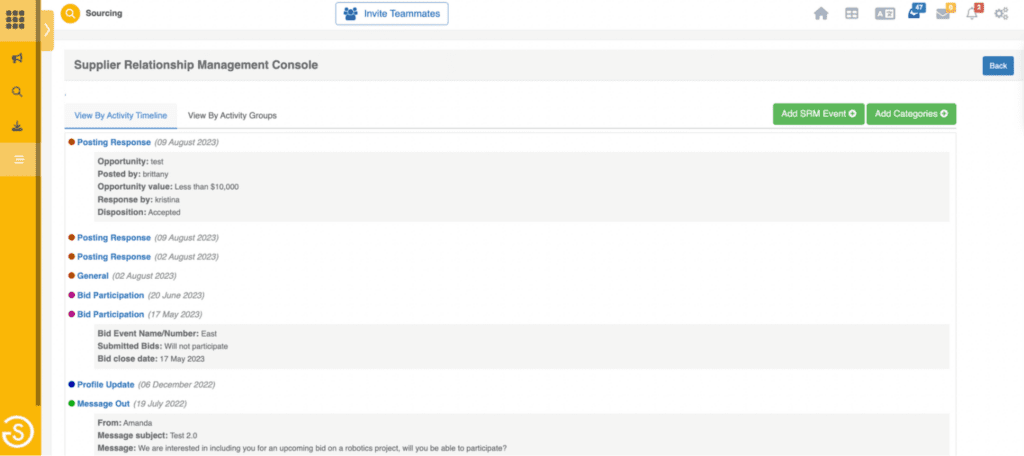
Easily communicate with potential vendors in SupplierGateway’s Supplier Relationship Management Console.
All in all, having a comprehensive vendor management system will go a long way in helping you build strong partnerships with your suppliers—and keep them going long into the future.
Setting Up Vendor Contracts and Agreements
Getting your vendor’s contracts and agreements in order is critical to onboarding. With the correct setup, you can streamline your operations and maximize efficiency.
Have a Clear Agreement in Place
Before you place your first PO, be sure to have an agreement that outlines what both parties will do and how they will do it. Include payment terms, legal disclaimers, and other necessary documents in the agreement. You’ll want to ensure everyone involved understands what they’re on the hook for—or else there might be misunderstandings down the line that can delay deliveries and payments or cause other issues.
Document Vendor Performance
It’s also important to document every part of the vendor’s performance—from onboarding to delivery—so you can ensure they meet any contractual obligations outlined in their agreement. Tracking everything from vendor communications to shipment dates protects your organization from potential litigation and other risks should anything go wrong.
Establish Clear Expectations
When setting up contracts and agreements with vendors, establish clear expectations about how each party operates and performs. Include terms for payment deadlines, quality control standards, turnaround times for products and services, and other guidelines about how the two parties should interact and work together during the onboarding process. When you start with clear expectations, you reduce the number of headaches you’ll have further down the line.
Improve Vendor Onboarding Best Practices with Automation
Onboarding suppliers is critically important to your organization. However, most vendor onboarding processes are manual and lead to incorrect supplier information. Gathering supplier information is time-consuming and tedious— no one enjoys chasing down information or pouring over spreadsheets.
That’s where automation comes in.
Automating some or all of your onboarding process creates a more streamlined experience for everyone. Allow suppliers to use a vendor onboarding platform to supply their information and get supplier data straight from the source.
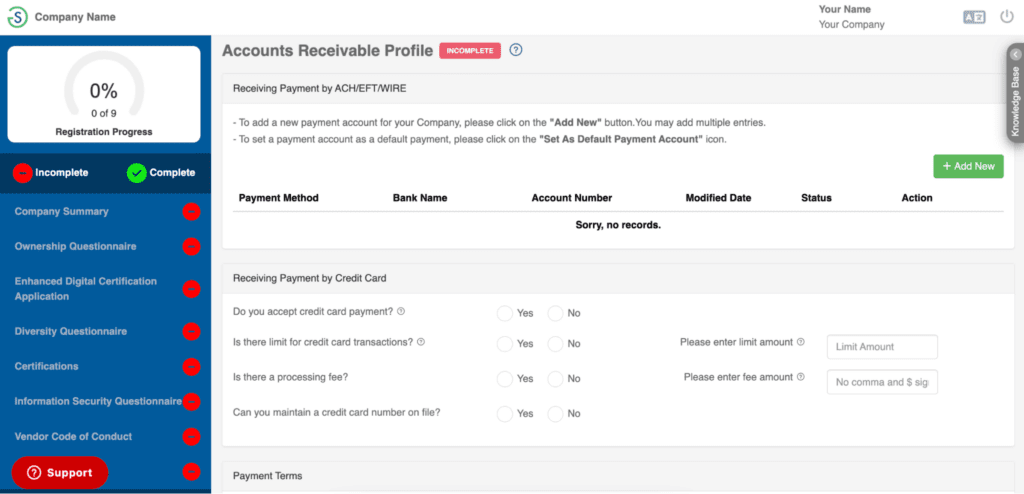
A streamlined onboarding experience with SupplierGateway.
Customizing your onboarding workflows speeds up the process and sets the tone for your relationship with a supplier. With custom onboarding workflows, you ensure that you only get data that applies to that specific supplier— no more asking general contractors for their relevant certifications.
Keep these best practices in mind when automating your onboarding process.
Set Clear Onboarding Goals
The first step in automating the onboarding process is to set clear goals. What are the KPIs that you want to measure? How much time do you want to dedicate to onboarding each supplier? Clear objectives help ensure that the onboarding process runs smoothly and efficiently.
Streamline Documentation
Another critical step in automation is streamlining documentation. Instead of manually collecting information from each supplier, look for ways to simplify the documentation process. For example, a vendor onboarding platform like SupplierGateway’s Supplier Onboarding Software makes it easier for suppliers to complete forms, helps eliminate redundant data, and helps ensure supplier data accuracy.
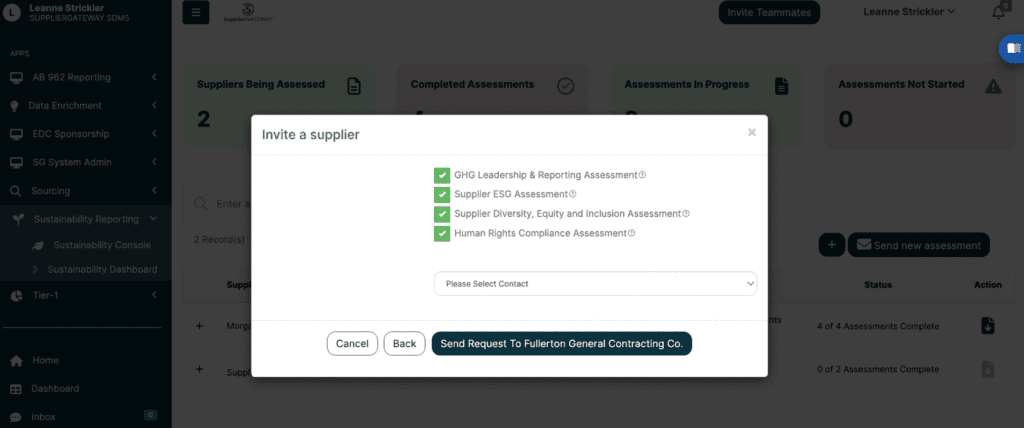
Invite vendors to complete multiple assessments during onboarding and maintain master records in one portal.
Having a single version of supplier data stored in one vendor portal makes it easier for tracking and analysis down the line. Since our software connects easily with your current ERP/AP systems via API, supplier data collected through your SupplierGateway onboarding portal and software can be easily populated and updated throughout multiple systems.
Schedule a demo to see our onboarding portal in action and learn how we can help you streamline your documentation process.
Automate Invoicing
Finally, consider automating invoicing processes so that payments get sent out automatically upon completion of work. Reduce manual effort on both sides and help ensure that payments are received on time – every time! Automated invoicing gives you access to real-time data on payments and vendor performance and helps inform business decisions about future projects.
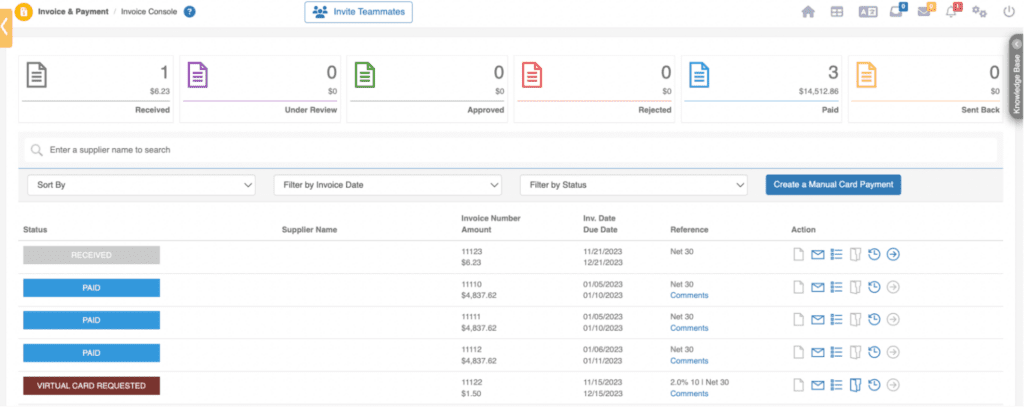
SupplierGateway’s Invoice Console provides transparency to invoicing and payments.
SupplierGateway’s Supplier Onboarding software includes an easy-to-use procure-to-pay system that allows you to pay your suppliers automatically. Receive 1% back on all your payments using SG Pay— saving time saves you money!
Ongoing Performance Management and Evaluations
The last step in vendor onboarding is the upkeep of the supplier relationship, known as supplier relationship management. Supplier relationship management ensures that your relationship with your suppliers remains beneficial. Regularly review supplier performance depending on their contractual obligations and assess them against established KPIs.
Supplier relationship management is outside the scope of this article, but you can read more about supplier relationship management in the following articles:
- Learn How Your Company Can Benefit From Supplier Management
- Maximizing Your Procurement Process With Supplier Relationship Management
- Suppliers, Not Strangers: Turn Your Suppliers Into Collaborators With Supplier Relationship Management
Streamline Vendor Onboarding with SupplierGateway
In short, vendor onboarding is a complex process and should be broken down into key steps. To ensure you have the best experience during onboarding, have appropriate processes, tools, and people in place.
Consider supplier requirements and provide a frictionless experience while remaining compliant with internal compliance policies and governing industry regulations.
Using the right tools and best practices, you can streamline the vendor onboarding process and make it faster and easier than ever. By leveraging the right technology and external data sources, you can reduce the time, effort, and cost associated with vendor onboarding and make sure you are working with the correct suppliers.
With SupplierGateway, you can get the most out of your vendor onboarding process and ensure it meets all requirements.












